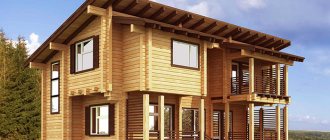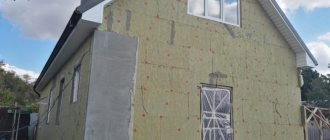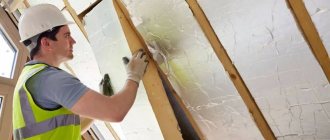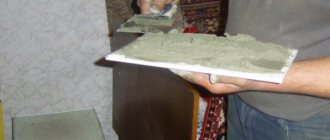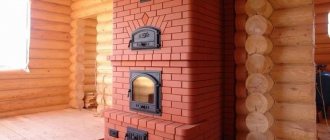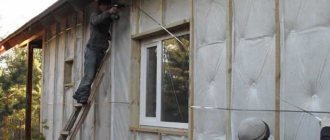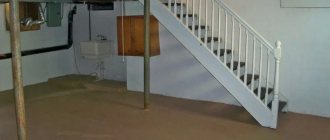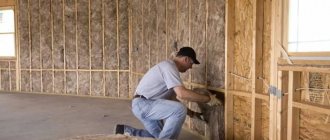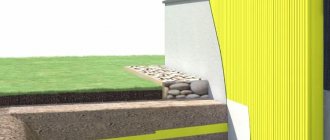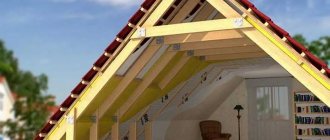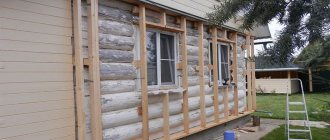Wooden buildings retain heat well. But if in warm climates the natural properties of wood are sufficient to maintain comfortable conditions in the house, then in regions with low winter temperatures the house must be additionally insulated. The heat insulator is installed on the walls, floor, ceiling - if any surface is left uncoated, the insulation of a wooden house from the inside will be less effective. It would be best to do the insulation during construction - it is much more difficult to carry out work in a habitable room
Insulation of a wooden house Source www.remontnik.ru
When installing insulation, a gap must be left between it and the finish for air circulation. This helps prevent the accumulation of moisture in the rooms, the appearance of mold and mildew.
How are wooden houses insulated inside?
Most often, houses made of timber are insulated inside with various types of construction wool - basalt (mineral), fiberglass and others. These are lightweight and affordable materials, environmentally friendly. The industry produces rolled and block types of wool.
Basalt wool retains heat well, but allows air to pass through. Thanks to this quality, fungus and mold do not appear in the rooms.
Rolled basalt wool Source fasad.guru
Glass wool absorbs a lot of moisture, so in order to avoid condensation, an additional layer of waterproofing is made for it. The big disadvantage of glass wool is its complex structure. The material is saturated with a large number of glass microparticles (hence the name). When working with cotton wool, they get into the respiratory organs and onto clothing. To work safely with glass wool, you need special clothing and a respirator.
All types of wool are easy to install. To install a heat insulator made of such material, high qualifications are not required. Rolled types of wool have high plasticity, but they are less dense compared to block types. When working with rolled materials, you can cut off the required amount of insulator. The tiles are made of the same size, so during installation of the sheathing, the sizes of the pieces are taken into account.
Cotton wool in slabs Source building.lv
Insulation of wooden walls is also carried out with polystyrene foam or polystyrene foam.
Expanded polystyrene is popular because of its low cost. In addition, it is easy to work with and retains heat well. It is a good sound insulator. The disadvantage is the release of toxic substances by the material during combustion.
Advantages and disadvantages
The main advantage of thermal insulation of the walls of a house using plasterboard is
- ease of installation;
- high efficiency of insulation;
- ideal surface for walls and ceilings for finishing.
The disadvantages include:
- the system of frame guides takes up space and volume, this is especially noticeable in compact rooms;
- low mechanical strength of the coating, does not withstand impacts;
- You cannot hang heavy objects without installing additional guides.
Insulating walls with plasterboard has a number of advantages and disadvantages.
Nevertheless, more and more rooms are being finished with gypsum board. Working with it does not require high qualifications or expensive specialized equipment.
Preparatory work
How to properly insulate the walls of a wooden house from the inside largely depends on the correctly selected materials. If this issue is resolved, then you can move on to preparatory work, which consists of preparing the surface and making the sheathing.
For reference! When preparing the surface, it is necessary to seal the gaps that may have appeared between the beams or logs. To do this, you will need additional materials: tow, felt or polyurethane foam.
Wooden bars are most often used as lathing. Metal sheathing is rarely installed. The metal for the sheathing must be coated with an anti-corrosion compound.
Vertical wood lathing Source uk.aviarydecor.com
Preparation of wooden surfaces
To ensure high-quality application of the insulator, prepare the surface for coating with insulation. Tow/felt/foam is placed in the cracks. After the gap is completely closed, the foam has dried and its excess has been removed, putty is applied to the wall. The putty layer is carefully leveled. The wood is coated with a special compound that protects against mold and mildew. All wooden surfaces are treated with a fire-retardant compound before installing insulation.
See also: Catalog of wooden house projects presented at the Low-Rise Country exhibition.
Where to begin?
Initially, you need to determine the type of wood from which the house is made, because there are heat-insulating species, and therefore costs can be reduced. The main thing is to identify the shortcomings and eliminate them, usually these are the appearance of cracks, improper filling of insulation, cracking of logs.
After identifying the shortcomings and determining the range of work, they begin to insulate the walls. In this case, the owners are faced with a choice of which side of the wall to insulate: internal or external. Internal insulation is simpler, although the external option has its advantages; sometimes the best way out of this situation is a combination of two methods.
The key to success is to correctly follow the technology of fastening the material and protect it from moisture. You can do the work yourself, because the process itself is not technically complex.
Basalt wool insulation technology
After the walls (ceiling) have dried after treatment, begin installing the insulation.
Stages of work when insulating walls with basalt wool:
- The outermost elements are determined . They are carefully checked using a level and plumb line, since further installation work depends on their position.
- Fix the first vertical block with screws and dowels.
- At a distance of 1 m, the next vertical strips and so on until the entire surface is covered with lathing. For the installation of rolled wool, the installation of the sheathing ends at this stage.
- If there are windows or doorways , separate bars are installed along their perimeter.
Lathing near windows Source 51unlim.ru
- To install a piece of heat insulation, a sheathing grid with horizontal elements is made. Horizontal strips are placed on the resulting vertical mesh at equal distances. The distances between the bars must correspond to the dimensions of the insulation. The result was a mesh for installing thermal insulation.
- Cotton wool is placed in the cavity between the fixed slats . When installing the heat insulator on the walls, do not use glue or other means for fastening. If the lathing is done correctly, the wool will fit tightly to the surface, but you must remember about the ventilation gap. If the ceiling is insulated, the insulation will have to be fixed.
Any cotton wool has a porous structure, so it accumulates moisture. Therefore, when insulating a wooden house with cotton wool, you should definitely cover it with a vapor barrier. When installing the roll material, cut off the required length and attach it to the wall. Before starting work, you should calculate how much material is needed to insulate a wooden house. Add 10% to the resulting number.
See also: Catalog of companies that specialize in home insulation.
Types of mineral wool
There are many legends regarding a simple question: can it be used indoors? We have all heard about the harmful environmental and physical properties of mineral wool. But let's figure out what is true and what is not.
There are three types of wool, depending on the raw materials of production:
- Glass. This type is made from molten glass. It is characterized by high fragility and causticity. If it comes into contact with the skin or eyes during styling, it causes severe itching. Not subject to rotting. Has a low degree of flammability. This type is not recommended for internal insulation work.
- Stone. The raw materials for its production are igneous rocks, mainly basalt is the most durable. Does not cause reactions upon contact with skin, does not support combustion. Another advantage is the form of release - slabs or mats are extremely convenient to install. This type is recommended for interior work.
- Slag. This type is made from waste from the metallurgical industry. The main disadvantage is the increased ability to absorb moisture. For this reason, it sags and becomes deformed. The moisture inside the cotton wool has a beneficial effect on the formation of fungi and microorganisms. Just as glass wool is characterized by its causticity and fragility, it is not recommended for internal insulation.
The production process uses formaldehydes, which are harmful to health, but they are used in such small quantities that they do not affect health in any way. And modern technologies have left their mark on this issue. Some manufacturers have replaced formaldehyde with bitumen in the technological process. However, we still recommend taking some preventive safety measures when insulating. The main one is to separate the room with a partition. We recommend using plasterboard or sheets of chipboard, OSB.
Video description
For some thoughts on the use of polystyrene foam and expanded polystyrene, see the video:
In particular, there are many complaints about the release of toxins during combustion, plus it is believed that foam plastic evaporates harmful substances into the air even at normal temperatures.
The material does not allow steam to pass through well, and in a room without good ventilation, moisture will constantly accumulate.
The advantages of the material include relatively easy installation, which means that workers will not be required to have high qualifications, and the cost of the work will be lower.
Polystyrene foam is available in slabs of various sizes and thicknesses Source on-woman.com
Stages of foam installation work:
- A lathing is installed on the pre-prepared surface with a pitch of planks equal to the size of the foam boards. Installation begins with load-bearing walls.
- Foam plastic is laid between the bars while maintaining a ventilation gap.
- A membrane film is fixed on top of the insulation . If it is possible to use other materials for other insulators, a special film with membranes is chosen for foam plastic. It will allow you to maintain a normal microclimate in the room.
- The installation of insulation is completed with finishing work .
Using drywall as insulation
Drywall, or gypsum board, is a thin sheet of gypsum, lined on both sides with layers of thick paper. Drywall has good strength and a perfectly flat surface, which is convenient to paint or wallpaper. It is easily mounted on prepared guides; you can cut the sheet into pieces of the required size and shape with a regular mounting knife.
All this makes gypsum board one of the most popular finishing materials. Can it also serve as insulation? By itself, no. Its thermal conductivity is determined by the thermal conductivity of gypsum, it is only half that of brick and ten times higher than that of mineral wool or other thermal insulation materials. In order for drywall to effectively retain heat, its layer must be several tens of centimeters.
However, the structure of the guides, which are mounted to install gypsum board on walls or ceilings, can be effectively used to place real insulation in it - sheets of mineral wool or foamed plastics. The surface of the plasterboard sheet will cover the thermal insulation from mechanical influences.
Floor insulation
Concrete floors must be insulated. Wooden ones are covered with a heat insulator if desired, but after insulation, the room will be much warmer.
Floor and wall insulation scheme Source daewoocenter.ru
In wooden houses, the insulation is laid on a subfloor and the finished floor is installed on top.
A film with a membrane, polyethylene, is used as a vapor barrier. Insulation using roofing felt is popular among people. This material has been known for a long time, it is cheap, protects well from moisture, and is durable.
Mineral wool is used as floor insulation. It is cheap, easy to install, durable, and has good heat and sound insulation properties. In addition, a relatively new material is increasingly being used - expanded polystyrene, which is gradually displacing cotton wool from the building materials market.
The sequence of actions when installing insulation on the floor of a wooden house.
- is leveled .
- A waterproofing is laid , the task of which is to prevent moisture coming from outside from reaching the insulation. In regions with wet soil, special attention should be paid to this stage.
- Install logs . The thickness of the logs must be at least 5 cm. The distance from the wall is 30 cm. The distance between the beams is 50 cm.
- Insulation is laid between the joists . The presence of voids between individual pieces of heat insulation is not allowed.
- A vapor barrier film is laid on top of the insulation .
- After all layers have been formed, the finishing floor .
Drywall
Today it is difficult to imagine renovation without the use of drywall.
It is multifunctional and is used for finishing walls, ceilings, creating partitions, and various decorative elements. Some types, due to their water-repellent properties, are used in finishing bathrooms and toilets.
Before using drywall, you need to understand its positive and negative characteristics in order to understand the specifics of handling it.
Advantages of drywall:
- Flexibility and lightness. The use of this material allows you to implement the most daring design solutions. It is easy to make various geometric shapes from it - from banal rectangular to complex semicircles, arches, columns;
- Thermal insulation properties;
- Fire resistance. Drywall doesn't burn. When it is exposed to fire, only the top paper layer suffers.
- Water resistance. Special types of gypsum boards have been developed that are recommended for use in rooms with high humidity.
Disadvantages of drywall:
- The main disadvantage is its fragility. A sheet of drywall can easily be damaged during transportation, installation, and subsequent operation;
- Soundproofing characteristics. Drywall does not have soundproofing properties. Behind a simple gypsum board partition all sounds will be heard.
Drywall
Vapor barrier
If there is a need to install a vapor barrier, it is better to use a special film with a membrane.
It will allow the walls to pass air normally, and after installation, condensation will not accumulate inside the “pie”. To install a vapor barrier, film or polyethylene is applied to the insulation. An allowance is made along the edges.
Film with membranes for vapor barrier Source kedrovdom.ru
What does the cost depend on?
The average price of work in the Russian Federation is from 200 rubles per square meter . The work includes several successive stages. Insulation is carried out separately:
- ceiling;
- walls;
- attic;
- gender;
- attics.
The cost of installing thermal insulation depends on the materials, technology, and location of the work . Insulation of the ceiling, interfloor ceilings, and floors in the presence of an unheated basement is carried out from below. This option is the most labor-intensive, installation of the material is carried out at a height, prices per m2 are calculated taking into account the increased coefficient.
Elimination of heat loss
The weakest points from the point of view of cold penetration are the joints. There should be no gaps between individual pieces of insulation. The insulating material is laid tightly to the sheathing. For floor insulation, an important point is the connection to the walls. In these places, the insulation is laid with a slight overlap on the walls and is fixed.
When applying a vapor barrier, make sure that each layer of material overlaps the previous one with a slight overlap.
The insulating material is applied directly between the wooden beams before insulating the walls of a wooden house from the inside. For this, long-known materials are used - tow, linen rope, flax wool. You can fill the joints of the beams with modern sealants - latex, acrylic, rubber.
Also, to reduce heat loss in a wooden house, the “warm seam” method is used.
Applying a warm seam
Requirements for thermal insulation thickness
Before deciding on the parameters of the material, you need to take into account a number of characteristics that affect them. The thickness of the thermal insulation depends on the climate conditions, what the building and walls are made of.
The following parameters will be required for the calculation:
- heat transfer resistance coefficient in the region;
- thermal conductivity of building and finishing materials, thickness of each;
- characteristics of the insulation itself.
The heat transfer resistance coefficient is established by building codes.
Data by region are indicated in SNiP. Table of some coefficients
| City | Resistance, m2 degrees/W |
| Moscow | 3.28 |
| Krasnodar | 2.44 |
| Rostov | 2.75 |
| Sochi | 1.79 |
| Saint Petersburg | 3.23 |
| Voronezh | 3.12 |
| Kazan | 3.45 |
You can find out the thermal conductivity coefficient of materials and the insulating membrane from the technical documentation attached to the product.
If you do not perform complex calculations for many situations, the optimal thickness of insulation for a standard frame structure is 150 mm . It meets the climate conditions of central Russia.
For severe winters, the insulation layer will have to be increased by installing thermal insulation and an additional frame.
The total wall thickness is brought to 200-250 mm. The thicker the walls, the thinner the insulation layer should be.
In terms of thermal insulation characteristics, 50 mm mineral wool is comparable to 50 cm timber.
To build a house for permanent residence, instead of 450 mm timber, profiled 150 and 100 mm are used; after shrinkage, the walls are insulated with material 50-100 mm thick.
The standard thickness of walls and insulation is provided for by SNiP 02/23/2003:
- In houses for living only in the warm season, the wall thickness is 150-200 mm without additional insulation. Resistance coefficient – 1.26 m2 degrees/W.
- To stay in a cottage in winter and summer, the heat transfer resistance should be about 3.06 m2 degrees/W. If you try to achieve this only due to the thickness of the timber, the walls can be about 50 cm.
But, if you use insulation and timber with a small cross-section, the design will be optimal. In practice, with a wall of 150-170 mm, 100 mm of mineral wool is sufficient for the heat transfer resistance to reach 3.1 m2 degrees/W.
Some good tips
- To avoid mistakes, you must follow the instructions exactly;
- For high-quality installation of the material, the slab must have a width of more than one meter;
- In order for mineral wool for wall insulation to last longer, it is necessary to create a high-quality vapor barrier;
- The material should lie tightly and evenly on the surface. When filling the grate with insulation, it is important to avoid gaps;
- Insulating walls with mineral wool slabs is much easier than using mineral wool in rolls;
- The wall on which the insulation is applied must not have cracks or defects.
Well, I would like to hope that this article will help the reader understand and understand what mineral wool is, what properties it has, and how to use it correctly to save heat in the house. Let insulating walls with mineral wool seem like an easy job with a positive result for everyone!
